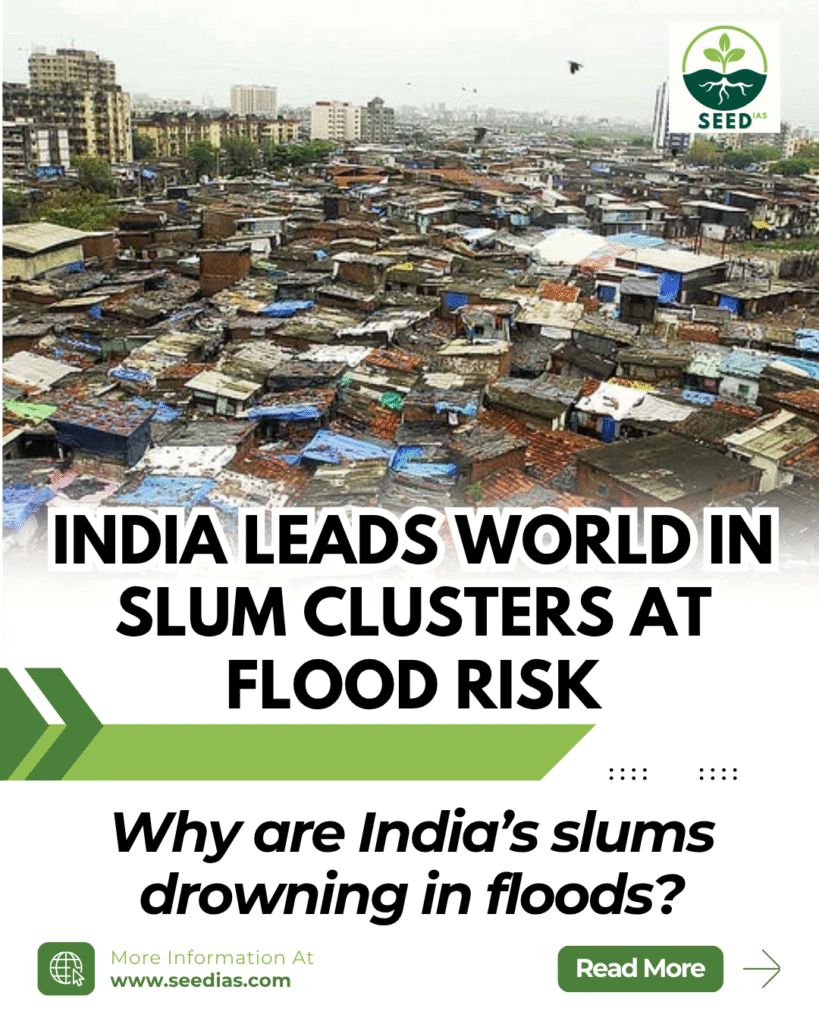Why in NEWS
A Nature Cities global study found that India has the world’s largest number of slum clusters in flood-prone areas, highlighting growing climate vulnerability and urban risk.
Key Terms / Concepts
| Term | Explanation |
|---|---|
| Slum | Poor, crowded settlement with inadequate infrastructure, sanitation, and housing. |
| Floodplain | Low-lying area adjacent to rivers prone to seasonal or flash flooding. |
| Flash Flood | Sudden local flood caused by heavy rainfall or dam failure. |
| Sponge City | Urban model that uses green infrastructure to absorb and manage rainwater. |
| IFLOWS-Mumbai / CFLOWS-Chennai | City-specific flood warning systems for risk forecasting. |
What the Study Reveals
| Key Point | Details |
|---|---|
| India’s Rank | India has the highest number of slum dwellers in flood-prone zones (158 million+). |
| Risk Zones | Ganga Delta, Mumbai, and other urban areas are most affected. |
| Global Pattern | Slum residents globally are 32% more likely to live in floodplains. |
| Other Countries | Indonesia, Bangladesh, Pakistan also have high slum-flood risk zones. |
| Impact | Displacement, job loss, poor access to sanitation, healthcare, and education. |
Flood Risk Drivers in India
| Factor | Impact |
|---|---|
| Riverine Floods | Overflow in Ganga, Brahmaputra, Krishna basins due to heavy rains. |
| Urban Expansion | Cities like Mumbai, Bengaluru encroach into floodplains. |
| Flash Floods | Rising due to extreme rain and saturated soil—184 cases in 2022. |
| Climate Change | Extreme rainfall doubled (1981–2020), monsoon intensified by 56%. |
| Poor Drainage | Outdated systems in metros cause urban waterlogging. |
| Plastic and Encroachment | Blocked stormwater drains worsen floods (e.g., Chennai 2015). |
| Strategy Gaps | Lack of region-specific risk plans and forecasting systems. |
Slum Scenario in India
| Indicator | Details |
|---|---|
| Definition | Compact housing with poor amenities; defined by Pranab Sen Committee (2010). |
| Population | 17% of urban India lives in slums (2011 Census). |
| State Trends | High slum numbers in Maharashtra, UP, Andhra Pradesh, West Bengal. |
| Governance | Housing is a State subject; Slum Clearance Act (1956) applies to UTs. |
| UN-HABITAT Criteria | Slums lack durability, sanitation, clean water, tenure. |
Government Schemes for Slum Development
| Scheme | Focus |
|---|---|
| PMAY-Urban | Pucca housing with amenities for slum dwellers—29 lakh units sanctioned. |
| AMRUT & Smart Cities Mission | Improve urban infrastructure including drainage, water supply. |
| Swachh Bharat Mission – Urban 2.0 | Waste-free city focus; targets sanitation in slums. |
Sustainable Solutions for Slum & Flood Management
| Strategy | Description |
|---|---|
| Region-Based Flood Plans | NDMP promotes topography-based flood risk strategies. |
| Zoning Laws | Prevent urban expansion into floodplains. |
| SUDS (Sustainable Urban Drainage) | Green spaces, rain gardens, permeable pavements to absorb rainwater. |
| Slum Upgradation | Elevated housing, better drainage under PMAY. |
| Data-Driven Monitoring | NRSC, IMD, IFLOWS/CFLOWS for mapping and forecasting. |
| Sponge City Model | Adopted in Shanghai and now Mumbai—manages water via green infrastructure. |
| Water Body Restoration | Lakes like Jakkur (Bengaluru) showcase eco-restoration for flood control. |
In a nutshell
Memory Code: “FLOOD SLUM”
Flash floods rising,
Low-lying floodplains occupied,
Overcrowding in cities,
Outdated drainage,
Data-driven solutions needed,
Sponge City concept,
Lakes restored,
Upgrade slums,
Monitored risk via tech.
Prelims Practice Questions
- Which of the following is a key feature of the Sponge City concept?
(a) Construction of high concrete embankments
(b) Use of artificial lakes in urban centers
(c) Use of permeable surfaces and green infrastructure to manage rainwater
(d) Construction of vertical housing to prevent urban sprawl - According to the recent Nature Cities study, India’s slum clusters are particularly vulnerable due to:
(a) High altitude settlements
(b) Lack of job opportunities
(c) Concentration in flood-prone areas
(d) Excess forest clearance - Which of the following cities is adopting the Sponge City model for flood management?
(a) Delhi
(b) Mumbai
(c) Varanasi
(d) Kolkata
Mains Questions
- Discuss the major factors responsible for increasing flood vulnerability in urban slum areas of India. (15 marks)
- Examine the relevance of the Sponge City concept for Indian cities in the context of urban flooding. (10 marks)
Answer Key with Explanations
| Q No. | Answer | Explanation |
|---|---|---|
| 1 | (c) | The Sponge City concept uses green infrastructure like permeable pavements, rain gardens to manage stormwater. |
| 2 | (c) | India’s slum dwellers, over 158 million, are heavily concentrated in flood-prone areas. |
| 3 | (b) | Mumbai is implementing Sponge City features to manage floods and groundwater recharge. |
















